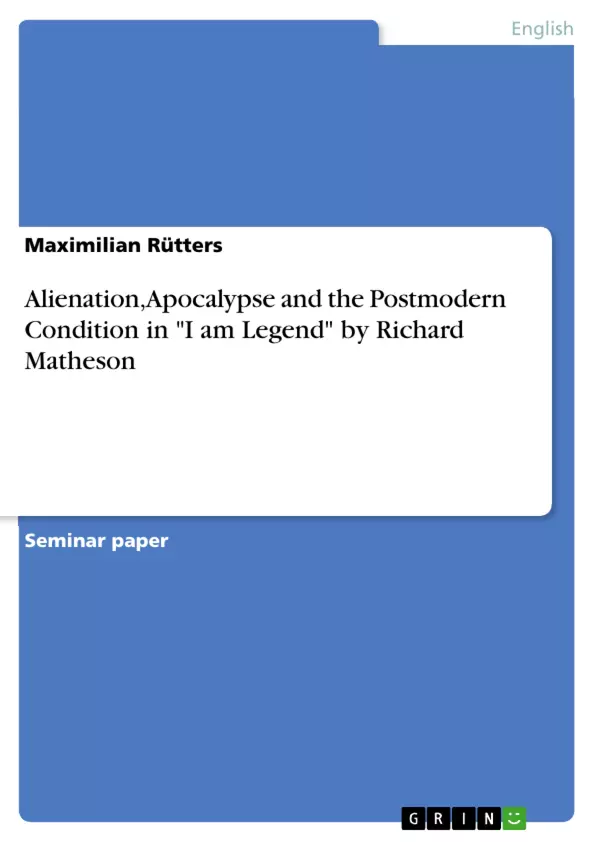The work that will be focused on the novel “I Am Legend“ by Richard Matheson brings together the idea of the last living human on earth and the myth of vampires. The author shows the theories of the novel that are hidden between the lines. These theories are on the one hand easy to find and very obvious but on the other hand they have to be decoded word by word. To be more specific, I will try to show that the condition of alienation is one of the main topics in Matheson’s writing. Moreover, I will show some postmodern aspect of the novel and why it is so fascinating to read apocalyptic writings. The novel may be written in 1954 and set in the late 1970s but it can be a model for current interpretations of the apocalypse since apocalyptic writings make sense of bad things and are coping with situations in which people feel helpless.
Inhaltsverzeichnis (Table of Contents)
- Introduction
- Richard Matheson
- A short version of I Am Legend
- Alienation, Postmodernism and the apocalypse
- The Apocalypse
- The postmodern condition and the apocalypse
- Alienation
- Conclusion
Zielsetzung und Themenschwerpunkte (Objectives and Key Themes)
This essay examines Richard Matheson's science fiction novel "I Am Legend" to understand the theories that are hidden within the work. The essay focuses on the themes of alienation, postmodernism, and the apocalypse.
- The novel explores the condition of alienation through the protagonist's isolation and struggles in a post-apocalyptic world.
- The essay investigates the postmodern aspects of the novel, particularly its exploration of the apocalypse as a cultural touchstone.
- The essay delves into the symbolic significance of vampires in the context of the novel, linking them to themes of societal fear and contradictions.
- The essay analyzes the novel's exploration of the human condition and its potential for resilience and adaptation in the face of adversity.
Zusammenfassung der Kapitel (Chapter Summaries)
The first chapter introduces the concept of apocalyptic literature and its historical context, highlighting its prominence in contemporary culture. The chapter examines the origins of the genre, tracing its roots to early works such as Mary Shelley's "The Last Man" and biblical narratives. It also emphasizes the growing interest in undead creatures, particularly vampires, and their cultural significance.
The second chapter provides a concise summary of Richard Matheson's novel "I Am Legend," focusing on the protagonist Robert Neville's struggle for survival in a world overrun by vampires. The chapter details Neville's daily routine, his encounters with the vampires, and his efforts to understand their nature and weaknesses. It also highlights Neville's emotional and psychological state, marked by isolation, despair, and a relentless desire to survive.
The third chapter delves into the themes of alienation, postmodernism, and the apocalypse as presented in the novel. It discusses how "I Am Legend" reflects the anxieties and uncertainties of a postmodern world through its depiction of a society in ruins and the breakdown of traditional norms. The chapter explores the concept of the apocalypse as a potent symbol of societal fear and disruption, and how the novel uses it to examine the nature of humanity.
Schlüsselwörter (Keywords)
The key themes and concepts explored in this essay include: alienation, postmodernism, apocalypse, vampire fiction, gothic literature, science fiction, societal fear, human condition, resilience, adaptation.
- Quote paper
- M.Ed. Maximilian Rütters (Author), 2015, Alienation, Apocalypse and the Postmodern Condition in "I am Legend" by Richard Matheson, Munich, GRIN Verlag, https://www.grin.com/document/1118803



